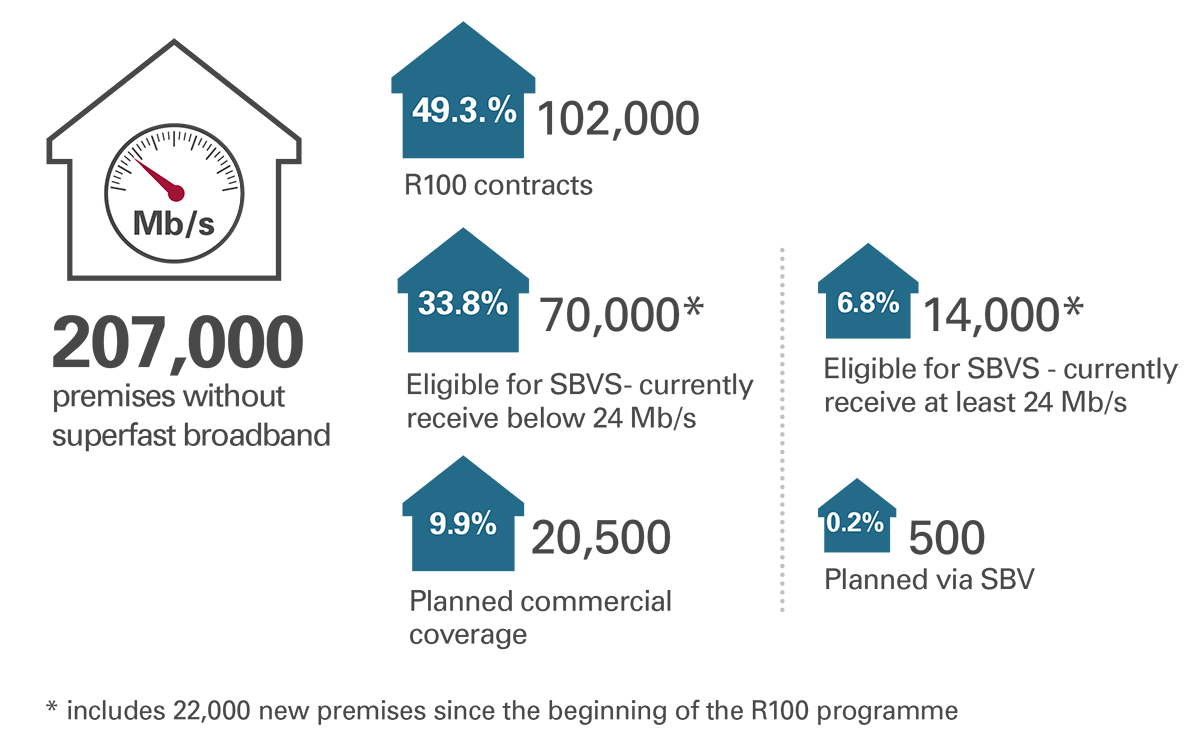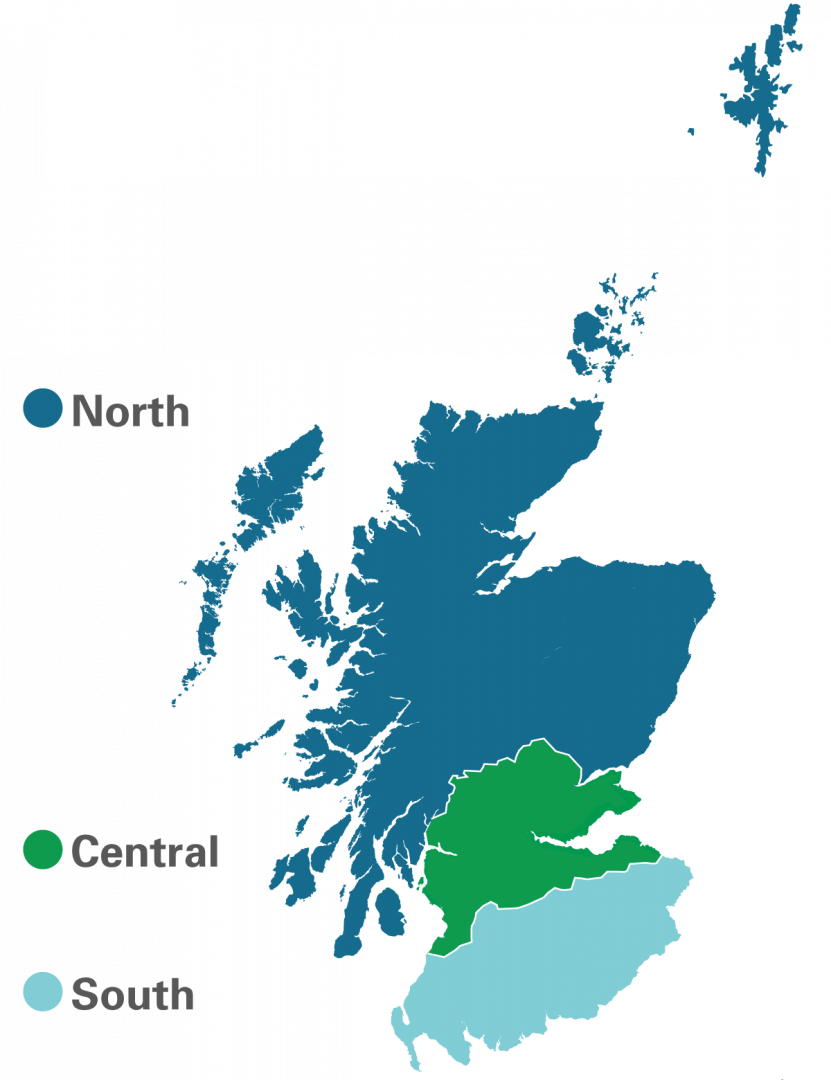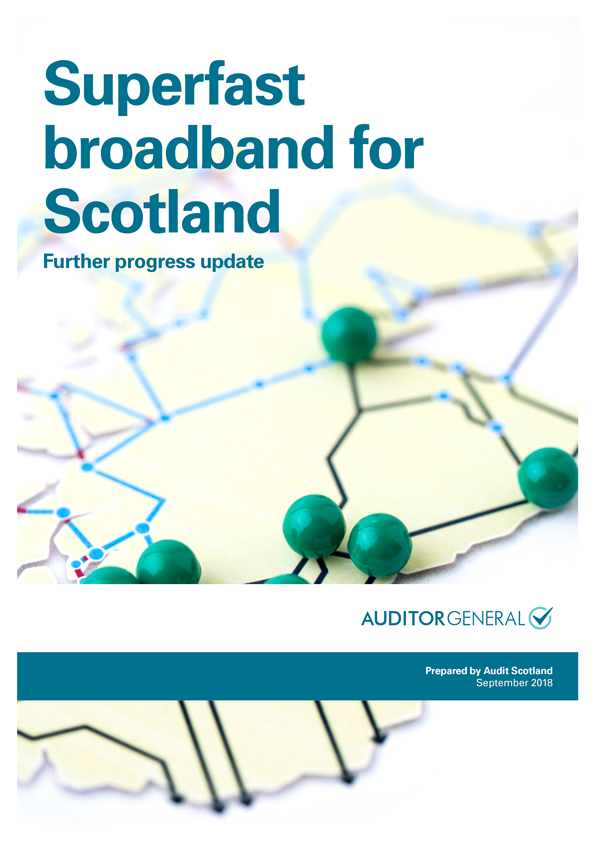Publication: Update on the Scottish Government's R100 programme
Update on the Scottish Government’s R100 programme

Update report
Why is broadband important?
The Covid-19 pandemic has highlighted that people need good broadband services, now more than ever. For keeping in touch with family and friends, working from home and accessing education, healthcare and other services.
Good connectivity is essential for economic growth, increasing productivity and innovation, and for sustainable public services and environment.
Scottish broadband facts
Ofcom estimates that:
93% of premises have access to superfast broadband
68% About 68% of premises that are able to get superfast broadband actually take it up
30,000 About 30,000 (1.1%) premises only have download speeds of less than 10Mb/s.
Figures are for residential and commercial premises combined.
What have we reported previously?
In 2018, Audit Scotland reported that the Scottish Government had met its target of providing access to fibre broadband to 95 per cent of premises in Scotland by the end of 2017. At that point, its superfast broadband programme (DSSB) had connected 890,000 premises. We stated that it would be challenging for the Scottish Government to deliver its commitment to ensure that every home and business in Scotland could access superfast broadband by the end of 2021 through its Reaching 100 per cent (R100) programme (launched in May 2016).
The programme’s target will be delivered through commercial coverage, three R100 contracts and the Scottish Broadband Voucher Scheme (SBVS).
The story since 2018
- Average speeds have increased significantly since 2018 through commercial and public sector investment. The DSSB programme reached around 951,000 premises with the total public sector investment currently estimated to be £311 million.
- Due to delays in finalising the R100 intervention area and awarding the North, South and Central contracts to BT plc., work will now continue until 2027 in some areas.
- There was a legal challenge to the North contract. This was resolved but the challenge meant that this contract was not awarded until December 2020. The number of premises covered by that contract had to be reassessed because commercial coverage had extended in the intervening period. This was not finalised until August 2021.
- Around 112,000 premises are now expected to be connected through the three R100 contracts.
- The Scottish Government launched the Scottish Broadband Voucher Scheme (SBVS) in September 2020. This enabled people who would not have access to superfast broadband by the end of 2021, or where there was no planned coverage, to apply for a voucher to get connected by another supplier.
- After a slow start, by 31 December 2021, around 107,000 premises remain to be connected through the contracts[1]. Many of these are in the hardest to reach locations, with the majority in the North. Connecting these remaining premises, will be challenging and expensive.

- Premises without superfast broadband: 207,000
- Planned commercial coverage: 20,500 (9.9 %)
- R100 contracts: 102,000 (49.3%)
- Planned via SBVS: 500 (0.2%)
- Eligible for SBVS - currently receive at least 24 Mb/s: 14,000* (6.8%)
- Eligible for SBVS - currently receive below 24 Mb/s: 70,000* (33.8%)
* includes 22,130 new premises since the beginning of the R100 programme
[1]Around 5,000 of these may already be able to access a superfast service through the SBVS or commercial coverage.↩
Key contract information
| South | Central | North | |
|---|---|---|---|
| Contract awarded | December 2019 | December 2019 | December 2020 |
| Estimated completion of infrastructure | 2024/25 | 2023/24 | 2026/27 |
| Fibre to the premises (FTTP) (%) | 100 | 95 | 100 |
| Contract value (£’m) | 133 | 83 | 384 |
| R100 Main contract eligible premises* | 20,740 | 32,216 | 59,276 |
| R100 Main contract connected premises* | 2,991 14% |
2,171 7% |
145 0.2% |
| Voucher schemes - installed vouchers* | 327 | 366 | 733 |
* as at 31 December 2021

R100 main contract investment
| South | Central | North | Unallocated | Total | |
|---|---|---|---|---|---|
| SG Funding (£’m) | 105 | 83 | 384 | 7* | 579 |
| UK Gov funding (£’m) | 21 | 4 | 8 | 33 | |
| Total Funding (£’m) | 126 | 87 | 392 | 7* | 612 |
| BT plc. Capital Contribution (£’m) | 5 | 12 | 16 | 33 | |
| Funding + Contribution (£’m) | 131 | 99 | 408 | 7* | 645 |
* £7 million of Scottish Government funding is to be reallocated due to recent remodelling within the South Lot.
- Around 9,000 more premises than originally planned will be fibre to the premises (FTTP) [North from 85% to 100%; Central 79% to 95%], because of additional funding of £12.5 million from the UK government’s Project Gigabit. FTTP provides gigabit capable speeds- exceeding the Scottish Government’s original commitment.
- The Scottish Government is currently working with the UK government to agree the eligible premises and funding for Project Gigabit.
- The average cost to connect premises has increased from around £4,000 to £5,690. This is due to the increase in the number of fibre to the premises connections, which are more expensive.
- The cost to connect premises varies significantly between and within the Lots due to the different geographies and spread of premises and technologies used. For example, the Scottish Government estimates that some island premises could cost around £20,000 to connect.
| South | Central | North | Total | |
|---|---|---|---|---|
| Number of Premises | 20,740 | 32,216 | 59,276 | 112,232 |
| Average cost per premises (£) | 6,303 | 3,090 | 6,889 | 5,690 |
- The programme also includes laying 16 subsea cables to help connect island communities. This is a significant upfront investment and build. The estimated cost is around £35 million with the cables due to be laid during 2022.
How many premises have been connected to date?
| South | Central | North | Total | |
|---|---|---|---|---|
| Connected premises | 2,991 (14 %) |
2,171 (7%) |
145 (0.2%) |
5,307 (4.7%) |
| Estimated programme spend (£' m) | 4.7 | 2.5 | 3.2 | 10.4 |
Spend figures include other costs such as the subsea element
What about the premises outwith the three R100 contracts and planned commercial coverage?
- Around 85,000 premises will be covered by the Scottish Broadband Voucher Scheme (SBVS), which launched in September 2020. There are two types:
- Main scheme - worth up to £5,000 for premises where no R100 contract or commercial roll-out is planned. It is designed to allow vouchers in a community to be combined to extend available funding.
- Interim scheme - worth up to £400 to help deliver an interim connection to those premises where roll out is planned after the end of 2021. Premises in more remote areas can claim a further £250.
- The schemes are demand-led meaning that the residents/owners need to contact a registered supplier to get connected. People with premises eligible for the main scheme can also apply for the UK Government’s Gigabit Voucher Scheme where eligible.
- By December 2021, 1,426 voucher connections (826 main scheme, and 600 interim scheme) had been installed, at a total value of £2.1 million. To allow more time for people to apply and secure a connection, the Scottish Government announced in November 2021 that it was extending the availability of the interim scheme until 31 March 2022.
- The original estimated cost of the scheme was between £22 million to £28.6 million based on a take up of 20 to 30 per cent for the main scheme and 3 to 4 per cent for the interim scheme.
Are people getting better speeds compared to 2018?
- Average speeds have increased significantly since we last reported in 2018. The Orkney Islands Council area is the only area where the average speed remains below 30Mb/s (18.7Mb/s). However, there may be premises throughout Scotland that cannot receive these speeds.
- Premises in the North Lot receive lower average speeds than elsewhere in the country. This is because of the geography and distance between premises. For the Central and South Lots the lowest average speeds are 47.3 Mb/s and 40.2 Mb/s respectively.
- Since we last reported, the number of premises unable to receive speeds of at least 10Mb/s has reduced from around 134,000 (5 per cent) to 100,000 (4 per cent). The majority of these are in rural areas (87,000).
- This overall number is significantly reduced from 100,000 to 30,000 when you include the premises that can access fixed wireless connections.
- There has been a large increase the number of premises able to receive faster speeds, particularly during 2021. Fibre to the premises is now available to 741,000 premises (26 per cent) of premises (2018: 63,000, 2 per cent), with giga-bit capable connections being available to 1.4 million (50 per cent). Link to footnote 1 Link to footnote 2
- Fibre to the premises enables better access to cloud-based computing services, increasing reliability and productivity.
Average broadband speeds (Mb/s) experienced by local authority areas in the R100 Lots
The graph represents which Lot the majority of the premises within a local authority area are included. The R100 Lots are split at a postcode level and are not strictly aligned to local authority boundaries. There will be some premises within East Ayrshire, East, Mid and West Lothians, Scottish Borders, South Ayrshire and South Lanarkshire, included in the data that sit within either South or Central. Argyll and Bute, North Ayrshire, Perth and Kinross, and Stirling may have some premises in either North or Central.
thinkbroadband.com allows the public to enter their postcode into a tool which measures the upload and download speed of their internet connection. It is the most up-to-date data available, but it is likely to be lower than other sources as people who are unhappy with their speeds are more likely to test them. Average speeds experienced are generally less than those modelled to be available. This is due to various factors including the package people select from their internet service provider.
Source: thinkbroadband.com speed data, December 2021.

What next?
- As noted earlier, there are around 107,000 premises yet to be connected, or upgraded, through the main R100 contracts so that they can receive superfast speeds. Build in some areas will continue until 2026/27 which means some households and businesses may continue to miss out on a reliable connection until then. Although options, such as the SBVS and further investment from the UK Gigabit scheme may help speed this up, this is potentially a long wait for some.
- As we reported in 2018, it will be important for the Scottish Government keep people informed on progress and be as transparent as possible.
- Connecting the final premises will be hugely challenging. Many are in the hardest to reach locations with difficult terrain. Commercial coverage and technology is also constantly changing, as is the number of premises to be reached. The Scottish Government will need to continue managing the contracts carefully to ensure BT plc. and its delivery partner Openreach, delivers to the current planned timescales, as well as monitoring wider commercial coverage.
- A reliable and futureproofed full fibre infrastructure is essential to ensure everyone has access to the same level of service provision, to allow the economy to grow and increase productivity, and to help Scotland meet its climate change targets.
- The Scottish Government needs to ensure it delivers all of its connectivity programmes, which includes the 4G infill and 5G programmes. This is a key commitment in its digital strategy published in March 2021.
- Building the infrastructure is only one part of the process. Broadband and data packages can be costly, and people need the necessary devices and the skills to access services.
- We will continue to monitor the Scottish Government’s progress in delivering its digital strategy and these key programmes, and how it is addressing digital exclusion in our future work programme.
Footnote
- Connected Nations 2021 Scotland report and interactive dashboard, Ofcom, December 2021 and Connected Nations update: Spring 2018, Ofcom, April 2018. ↩
- Since the 2018 report, Ofcom has changed how it calculates the premise base- see Ofcom’s methodology. ↩








